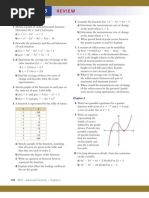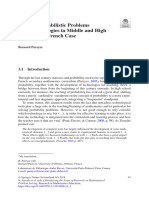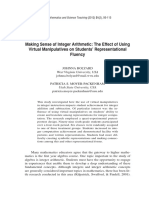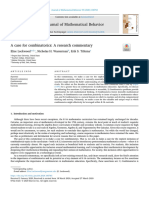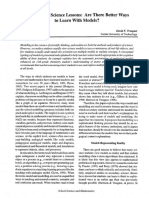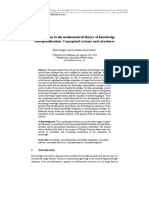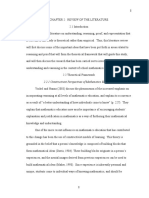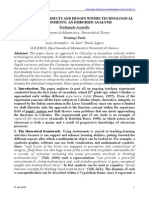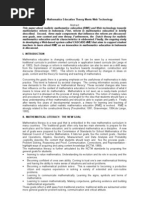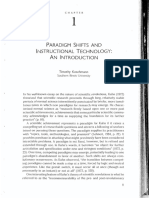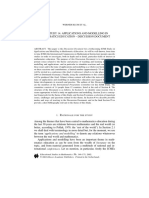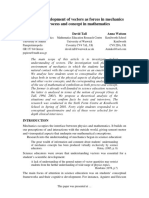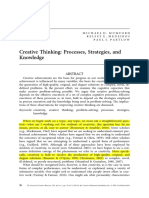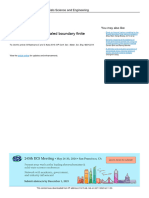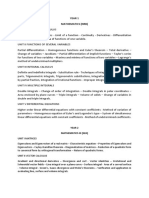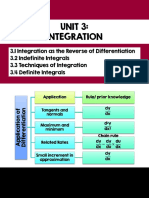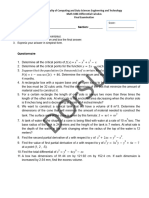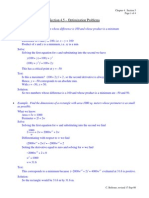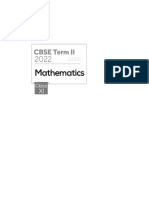Meaning The Derivative in A Modeling Context To Help Understanding
Meaning The Derivative in A Modeling Context To Help Understanding
Uploaded by
Maximiliano CervantesCopyright:
Available Formats
Meaning The Derivative in A Modeling Context To Help Understanding
Meaning The Derivative in A Modeling Context To Help Understanding
Uploaded by
Maximiliano CervantesOriginal Title
Copyright
Available Formats
Share this document
Did you find this document useful?
Is this content inappropriate?
Copyright:
Available Formats
Meaning The Derivative in A Modeling Context To Help Understanding
Meaning The Derivative in A Modeling Context To Help Understanding
Uploaded by
Maximiliano CervantesCopyright:
Available Formats
Journal of Mathematical Modelling and Application
2011, Vol. 1, No. 4, 20-32
ISSN: 2178-2423
Meaning the derivative in a modeling context to help understanding
Maximiliano Cervantes Salazar
Centro de Estudios Superiores del Estado de Sonora, Mexico
csmaximiliano@gmail.com
Abstract
Since Newton and Leibniz, the understanding of the theoretical foundations of the derivative has been
a source of difficulties. This results in teaching and learning processes is chosen to achieve mastery of
rules and procedures rather than conceptual aspects. The domain of the latter is desirable professions
in various fields. In the case of engineering practice, this requires a high level of ability in using
mathematical tools and therefore the conceptual aspects. Efforts to improve learning of the main
concepts of calculus, and in particular of the derivative, including didactic proposals in various
theoretical positions. However, most of these proposals rely on the definition of derivative given by
Cauchy. It is suggested that this definition, received and taught as a cultural product, is the leading
cause of learning difficulties. It is therefore necessary to seek new approaches to broaden their
understanding. This essay describes how to obtain the derivative for polynomial functions in the
context of modeling based on quantities. This context we have called the approach to modeling. It is
proposed that this description of the derivative helps to understand the cultural notion of derivative
and opens new lines of research in mathematics education.
Keywords: Derivative, modeling, understanding.
1. Background
The derivative is a complex notion. Its evolution as a concept involves three basic concepts,
the rate of change at one point, the tangent to the curve or differential ratio and the notion of limit. The
conceptualization and to relate these notions and apply them in problem solving are among the main
difficulties in learning. This has led to in learning of differential calculus predominates the domain of
algorithms and rules with serious deficiencies in the conceptual (Artigue, 1995, Dolores, 2000,
Moreno and Cuevas, 2004, Bloch and Schneider, 2004).
In the case of industrial engineering, learning algorithms represent a serious disadvantage.
Engineering education requires a considerable portion of mathematical modeling (Mendible and Ortiz,
2007; Vargas, 1998) whose domain requires the relational understanding of Skemp (1976). In other
words, the future engineer must not only know how to apply procedures or mathematical rules
associated with the calculation, but must also know the why of them so they can adapt them to model a
problem. The learning of the derivative is no exception to the latter.
Efforts to overcome the difficulties associated with learning of the derivative include
educational proposals in various theoretical positions. These proposals range from creating previous
experience through the use of the laboratory or software (Bloch and Schneider, 2004; Tall, 2004; Tall
and Mejia , 2004), to the use of new perpectives as the trend behavior of the functions and variational
thought and language in the focus sociepistemolgico (Lamb, 2001; Cantoral, 2004, Cantoral, Farfn,
Lezama and Martinez, 2006; Cantoral and Myron, 2000). In other efforts, as reported by Sanchez-
Matamoros, Garcia and Llinares (2008) research focuses explicitly on the understanding of the
derivative as an object of study.
Snchez-Matamoros, and Llinares Garca (2008) identify two types of theoretical perspectives
used by researchers in understanding of the derivative. In the first of these theoretical approaches are
based on elements of cognition, such as the conceptual framework, the APOS theory or theories of
reification. In the second type, these authors point socioepistemologic approach, extending the study
of the generation and dissemination of knowledge to a social, historical and cultural perspective.
Significantly, despite the theoretical approach most of the research work about the definition
of the derivative as a limit proposed by Cauchy. This poses difficulties. This definition has a complex
http://proxy.furb.br/ojs/index.php/modelling/article/view/1848 5 sept 2011
Meaning the derivative in a modeling context to help understanding
21
historical developments involving more than a century to formalize. Newton had the notion of limits
as the "ultimate ratio" (Boyer, 1959) and Leibniz as the "last thing" (Dunham, 2005) in the
seventeenth century when the two created the calculus. However, it was not until the nineteenth
century when Cauchy formalized the notion of limits based on the idea of proximity to a border
(Dunham, 2005). It is clear that the notion of limits arises, as indicated by Dolores (1999) to the
"impossibility" of having rates of change at one point or in an instant by arithmetic technique. This
"impossibility" is a natural question on the limit and its existence as Berkeley did in 1734. The
following paragraphs describe how in some situations can be overcome such "impossibility."
2. Theoretical background
Speaking of understanding is to talk about the appropriation of meanings shared by a
community of experts or institution (Godino, 2003; Batanero Godino, 1994). Socially, these meanings
are part of a cultural semiotic system built and inherited by the society over time (Radford, 1998).
However, the meanings may have a difficult web of ownership relations, as in the case of the concept
of the derivative. From the perspective of meaningful learning, to understand this concept or to
appropriate the meanings requires three conditions, the interest of apprentice, the presence of previous
ideas that serve as a link to the new material, and that the material is "plausible, reasonable" (Ausubel,
2002). It is thought that the first two conditions are not the source of the problems associated with
understanding, rather, is the derivative of Cauchy, which inherited learning material from culture
requires further clarification. That is, improving the learning of the derivative to be found in new
approaches to cultural definition.
Another aspect relating to the appropriation of meaning, is that they emerge from the context
in which they originate. Brown, Collins and Duguid (1989) argue that when we recall something we
have learned, we recall the contextual experiences that we learned, that is, learning is situated. This
explains the concern about the specific context in which it would be desirable to learn about
derivative.
In engineering social justification to study and learn mathematics is to use their methods in
solving the real problems of the same engineering (Niss, Blum y Galbraith, 2007). In other words, the
justification is the use of mathematical modeling itself, since it focuses on solving real problems (Niss,
Blum and Galbraith, 2007). This point is crucial for assessing the importance of learning of
mathematics in engineering, because students can learn mathematics and modeling at the same time
but are not aware of it (Greer and Verschaffel, 2007).
In education, the modeling has two main uses, as a vehicle to learn mathematics or as an end
in itself. However, the modeling lacks widespread use in higher education (Julie and Mudaly, 2007,
Houston, 2003). This was even more significant considering that the learning of mathematical
modeling and situated learning suggest greater use of modeling contexts. It is considered that a viable
way to promote the modeling is to expand the meaning of certain mathematical concepts as models in
themselves, including the notion of derivative.
3. The approach to modeling (ATM)
The approach to modeling is a conceptual framework in developing for industrial engineering
students. The aim is to present a mathematical closer to the daily activities of measuring and counting,
that gives them more meaningful and motivating learning (Cervantes, 2008). In this approach a model
is a representation of a specific reality, which can be modified and provide new information, usually
needed to solve a problem. According to Krick (1995, p. 65) the mathematical models used for
engineering design have these elements:
Through the use of mathematics can be predicted [...] natural phenomena, as well as the behavior of
devices, structures and manmade processes. Using the system of rules and conventions laid down by the
math, and assigning symbols to represent important properties of the real object, the mathematical
expressions can be manipulated to obtain useful predictions of what should be expected under certain
conditions.
Maximiliano Cervantes Salazar
22
The symbols and concepts that underlie these mathematical models have meanings very own
modeling activity. Consequently, the learning of mathematics should include such meanings. Under
this way of thinking is developing the approach to modeling, built from three basic premises:
a) Mathematics is a product of human activity as postulated Freudenthal (Gavemeijer and
Terwel, 2000). The approach to modeling based on the premise that initially mathematics
emerged as the mathematical modeling of human activity on its environment,
b) The modeling activity is made based primarily on the amounts that represent the problem
and their relationships.
c) The mathematical concepts thus generated have a meaning of model for
1
quantities
relations
2
Based on the approach to modeling have developed some ideas for learning about the
derivative as a model for the relationship between two variations at one point. I believe that these ideas
can help bring a new approach to the cultural notion of derivative and improve their understanding.
4. Problems of understanding of the derivative
Snchez-Matamoros, Llinares and Garca (2008) indicate that the factors that affect the
characteristics of meaning built on the derivative, are the context, modes of representation, the
functions features and the concept image. Likewise, in the development of these meanings influence
the integration of the meanings of ( ) a f ' and ( ) x f ' , the connections between the graphical and
analytical methods, and the construction of the derivative scheme.
The specific problems encountered on the understanding related to the above factors. As for
the context, Snchez-Matamoros, Llinares and Garca (2008) point out that the reports suggest that
students do not relate the ideas learned in one context to another context again. They add that this will
be achieved when the students recognize concepts such as limit, function and ratio in different
contexts. In terms of modes of representation, these authors suggest that students do not relate the
graphics contexts and analytical algorithms, confuse ( ) a f ' with ( ) a f , and dont relate the graphic,
numeric and analytical modes. Similarly such authors mention that the research suggests that various
concepts associated with the resulting image, while helpful, can also cause confusion.
As to how meanings are developed or the derivative scheme, Snchez-Matamoros, Llinares
and Garca (2008) reported investigations indicate that such development is related to the integration
of the meanings of ( ) a f ' and ( ) x f ' , and the connections between graphic and analytical. Snchez-
Matamoros, Llinares and Garca (2008) refer to Harel et al (2006) and their agreement with them that
learning a concept is achieved through its connections with other concepts, modes of representation
and knowledge of properties and processes. In short, it is necessary to clarify connections, modes of
representation, properties and processes, so as to minimize the problems of understanding mentioned.
How can you make this last? I suggest that an alternative is to expand the meaning of the derivative
based on a modeling activity as described below.
5. The derivative in the context of modeling with the ATM
D'Ambrosio (2009) argues that the typical strategy of humanity to produce knowledge and
learning is modeling. In it, a problem situation is subject of analysis and study by human beings in
order to generate information or explanations. Such explanations are the basis of theoretical models
that are refined in the light of new knowledge. Thus the human being generates knowledge and learn.
1
Term created by the realistic mathematics education and refers to the mathematical symbolism describes
general problems common to different situations.
2
Size, union, separation and variation relationships. The structure of these relationships is found in problem
situations and in the emerging concept in modeling such situations. Thus the relationship of any union of
quantities has a structure characterized by any two or more quantities that bind. This structure gives rise to the
concept of addition. Accordingly, it has a meaning as a model for such a structure of relationships. That is, a
model for the union of any quantities.
Meaning the derivative in a modeling context to help understanding
23
In the modeling approach to mathematics, is privileged the interpretation of the symbolic models built
in mathematical activity in terms of quantities. Through these tangible reality can be expressed
symbolically with greater accuracy. The following describes how to interpret the derivative in the
approach to modeling. I use some stages of mathematics in context given by Camarena (2004).
5.1 The problem
The typical situation that generates the notion of derivative is related to a particular type of
variable. There are variables that expresses the reality tangible dimensions such as length, weight and
time, which can be quantified directly. There are more complex variables that are expressed with a
combination of relations between various dimensions, such as work done by a force ( ) d F W = , the
pressure on a surface
|
.
|
\
|
=
A
F
P , the velocity of an object
|
.
|
\
|
=
t
d
v , the productivity of a company
( ) t p P / = , among others. The quantification of these variables is sometimes very complex.
The situations associated with the use of the derivative, are those that require instant quantify
the relationship between two variations. Get one-off measure for variables associated with length,
weight or time is relatively easy. But how do you get the measurement point for a variable such as
speed, expressing the relationship between the change in distance and time? Moreover, how such
precise relationship model? Not enough to divide the magnitude of variation between the other point
to quantify the relationship between the two variations. This would express an average relationship,
not a precise relationship. The problem is therefore, to quantify at one point the relationship between
two variations.
5.2 The variables and their relationships
Quantify the relationship between changes at one point requires identifying the variables and
relationships to do so. To describe a typical first variable is considered that quantify such relationship
requires a comparison of the sizes or magnitudes of changes. This is accomplished by dividing them.
Thus, if y A is the variation expressed by the numerator and x A is the variation expressed by the
denominator, then
x
y
A
A
quantifies the average relationship between these variations and is
designated variable rate of change. It expresses the changing units y A for each unit change x A . That
is,
x
y
A
A
expresses a constant ratio for the range | |
n
x x ,
0
of variation x A . This relationship is
expressed graphically by the slope of the line rate of change. This is shown for the points ( )
0
,
0 x
y x ,
( )
n
x n
y x , in Figure 1:
Variable: rate
of change
n
x
y
0
x
y
Figure 1. Variable rate of change
0
x
n
x
| |
1 0
x x x
y
A
A
x
y
Maximiliano Cervantes Salazar
24
The rate of change is a variable that can be used to express the average velocity of an object, if
y A is the distance traveled for this purpose and x A represents the time spent on it. Similarly, the rate
of change can express an average acceleration, average productivity or average relationship between
two variations. It is plausible to consider that the variable rate of change can be used to quantify a
typical second variable: the rate of change at one point.
In the ATM the rate of change at a point is called variable rate of change at one point and is
symbolized as
dx
dy
or y' . This expresses a complex dimension of the tangible reality that is described
through the relationship at one point between two variations. Its used the symbolism of Leibniz to
minimize the complexities of a new one. However, the term
dx
dy
refers to a variable can only be
described by a rate of change at a point. That is,
dx
dy
expresses a rate between the size of the variation
expressed in the numerator dy and the denominator dx. So, if dy expresses the change in position of
an object and dxits running time on it, then
dx
dy
expresses the speed of the object at a given point of
time. Similarly, the variable rate of change at a point can describe instantaneous acceleration, instant
productivity, etc. The rate of change at a point ( )
i
x i
y x , is expressed graphically by the "line rate of
change at a point"
i
x
dx
dy
whose slope describes the relationship of sizes
dx
dy
at
i
x . This is shown in
Figure 2.
The existence of the variable rate of change at a point
dx
dy
implies the existence of four
variables typical: the independent variable x that causes the variation dxand x A , the dependent
variable y that causes the variation dy and y A , and variables
dx
dy
,
x
y
A
A
. The Figure 3 shows the
typical variables.
Variable: rate of
change at a point :
Figure 2. Variable rate of change at point
Meaning the derivative in a modeling context to help understanding
25
5.3 Formulation of model
5.3.1 The derivative as a function modeling rates of change at a point when the variable has a
quadratic function
Up to this point have been identified and described variables closely related with the variable
rate of change at one point, whose values we want to quantify. To build a symbolic model to provide
these values, we start from the idea that the only way to quantify a rate of change at one point, is using
the rate of change. It expresses the same relationship between the variations y A and x A . Therefore
x
y
A
A
provides the average rate of change that is equivalent to the same rate of change at a point
p
x
dx
dy
for
every point
i
x in the interval x A . This value
p
x
dx
dy
is also calculated as the average of all rates of
change at a point in the range mentioned, so
=
= +
=
n i
i
x x
i p
dx
dy
n dx
dy
0 1
1
. Since the average rate of change
p
x
dx
dy
tends to be central to all rates of change at one point
i
x
dx
dy
in the interval x A , there may be a
point where
i p
x x
dx
dy
dx
dy
= . This is, the values of the rate of change and the rate of change of that point
are equal.
In the search for the conditions under which the above is possible, the interval x A is divided
into even number of n parts, each of size x o as the unit of measurement. So
n
x x x ,... ,
1 0
are the point
values expressing the position or the point
i
x , at which there are
i
x parts x o of the independent
variable x . Each point
i
x corresponds a value
i
x
dx
dy
. These values
i
x
dx
dy
are steadily increasing amount
dx
dy
o going from one point to another. The conditions described are expressed as conditions of
"linearity" shown in Figure 4.
Figure 3. Typical variables:
x
y
dx
dy
y x
A
A
, , ,
Maximiliano Cervantes Salazar
26
The above conditions guarantee that
| |
0 0
, x x x x
dx
dy
dx
dy
x
y
p n
= =
A
A
. That is, the value of the rate of
change is equal to the rate of change of the point
c
x located at the center of the range
0
x x x
n
= A .
This is
o p
x x = . This can be demonstrated as follows.
| |
|
|
.
|
\
|
+ + + + + + +
+
=
+
=
A
A
=
=
n x x x x x
n i
o i
x x x
dx
dy
dx
dy
dx
dy
dx
dy
dx
dy
dx
dy
n dx
dy
n x
y
n i n 1 0 2 1 0 0
... ...
1
1
1
1
,
By putting each value
i
x
dx
dy
in terms
0
x
dx
dy
we have
| |
( )
(
(
(
(
(
(
|
|
.
|
\
|
+ +
|
|
.
|
\
|
+ +
+
|
|
.
|
\
|
+ +
|
|
.
|
\
|
+ +
+
=
A
A
dx
dy
n
dx
dy
dx
dy
n
dx
dy
dx
dy
dx
dy
dx
dy
dx
dy
dx
dy
n x
y
x x
x x x
x x
n
o o
o o
0 0
0 0 0
0
1
... 2 1
1
1
,
| |
( ) ( )
(
(
|
.
|
\
|
+ + + + +
+
= =
A
A
dx
dy
n
dx
dy
n
n dx
dy
x
y
x x x x
p n
o ... 3 2 1 1
1
1
0 0
,
| |
( )
( )
0 0 0 0
2 2
1
1
1
1
, x x x x x x
dx
dy
dx
dy n
dx
dy
dx
dy n n
dx
dy
n
n dx
dy
x
y
p n
= |
.
|
\
|
+ =
(
(
|
.
|
\
| +
+ +
+
= =
A
A
o o
| |
( )
( )
xc x x x x x
dx
dy
dx
dy n
dx
dy
dx
dy n n
dx
dy
n
n dx
dy
x
y
p n
= |
.
|
\
|
+ =
(
(
|
.
|
\
| +
+ +
+
= =
A
A
o o
2 2
1
1
1
1
0 0 0
,
Variable
Figure 4. Variables
dx
dy
x,
in conditions of "linearity"
Variable
Meaning the derivative in a modeling context to help understanding
27
It is now necessary to identify under what conditions the rate of change at a point is linear.
For the expression
| |
c
o n
n
x n
x x
x x
dx
dy
x x
y y
x
y
=
=
A
A
0 ,
0
be true and achieve the conditions of linearity, is
required an
c
x at the center of the range x A , and
i
x
dx
dy
be modeled with a linear function of the type
b ax + . So we need work with functions. By putting the expression
| |
c
n
n
x n
x x
x x
dx
dy
x x
y y
x
y
=
=
A
A
0 ,
0
0
in
terms of the corresponding functions, we have ) (
( ) (
'
0
) 0
c
n
n
x f
x x
x f x f
=
. The symbol ) (
'
c
x f
expresses the function that provides the rate of change of
c
x . If x x x
c n
A + =
2
1
, x x x
c
A =
2
1
0
and
0
x x x
n
= A then
x
x x f x x f
x f
c c
c
A
A A +
=
)
2
1
( )
2
1
(
) (
'
.
The conditions of linearity is achieved when ) (x f is a quadratic function
c bx ax x f + + =
2
) ( :
x
x x f x x f
x f
c c
c
A
A A +
=
)
2
1
( )
2
1
(
) (
'
x
c x x b x x a c x x b x x a
x f
c c c c
c
A
(
+ A + A
(
+ A + + A +
=
)
2
1
( )
2
1
( )
2
1
( )
2
1
(
) (
2 2
'
x
c x
b
bx x
a
x ax ax c x
b
bx x
a
x ax ax
x f
c c c c c c
c
A
(
+ A + A + A + A + + A + A +
=
2
) (
4 2
) (
4
) (
2 2 2 2
'
b ac
x
x b x ax
x f
c
c
c
+ =
A
A + A
= 2
2
) (
'
The function obtained is called the derivative function
3
because it is another function of
the independent variable . Thus the expression that models the rate of change in a central point
under the conditions described is .
As explained here, I show how to obtain the values of a variable rate of change in a central
point, in a context of symbolic modeling based on quantities. However, the above can be applied only
in situations that the variable is modeled with quadratic functions.
5.3.2 The derivative as a function modeling rates of change at a point when the variable is
modeled with a polynomial function
3
Named for Augustin-Louis Cauchy to indicate its dependence on the independent variable (Grabiner, 2005).
Maximiliano Cervantes Salazar
28
When the variable is modeled with quadratic functions the point is at the center of the
interval . It is determined that
| |
i p n
x x x x
dx
dy
dx
dy
x
y
= =
A
A
,
0
. The latter can not be assured when the
variable does not follow a quadratic function. Then, how to use the ratio
| |
n
x x
x
y
,
0
A
A
to identify the
rate of change at a point which is in any position in It is possible to answer the previous
question, if we consider two facts: a) the rate
p
x
dx
dy
has a constant value independent of the calculation
point , b) the rate
i
x
dx
dy
is independent of the magnitude of Consequently, when calculating
p
x
dx
dy
from a point , the result includes the rate
i
x
dx
dy
plus the corresponding difference to match
p
x
dx
dy
. This is
(
(
+ =
i p i p
x x x x
dx
dy
dx
dy
dx
dy
dx
dy
or if used functions that provide such rates of change,
This last expression can be corroborated in terms of linearity as
follows.
Let ; the point that calculates the rate of change
| |
n
x x
x
y
,
0
A
A
; the ratio
0
0
x x
x x
n
i
, then y . This implies that the rate of change in
point calculated from any point is modeled with the expression
In terms of linearity must be and . Then
After performing the algebraic steps and regroup factors:
What can be expressed generally as:
Meaning the derivative in a modeling context to help understanding
29
The above has several implications: a) the derivative obtained from a function and the
ratio
x
y
A
A
is the derivative , b) provides a average rate of change
p
x
dx
dy
that tends to
be located in the center of all values
i
x
dx
dy
, that is, tends to be at the center of , c)
includes the derivative of the calculation point plus the corresponding difference
, and d) can be identified in independent terms of in the ratio
x
y
A
A
.
In the ATM, the terms referred to in subparagraph d) are identified with the expression tiic. So
the derivative of a polynomial function can be determined from the tiic, this is
x
y
tiic x f
A
A
= ) (
'
. If
the calculation point is the point located at the beginning of the interval (such as Newton and
Leibniz thought), the ratio
x
y
A
A
is expressed as
x
x f x x f
x
y
A
A
=
A
A ) ( ) (
and the derivative is
(
A
A +
=
x
x f x x f
tiic x f
) ( ) (
) (
'
.
6. By way of discussion
In section four we argue the need to reduce the problems associated with understanding of the
derivative. Snchez-Matamoros, Llinares and Garca (2008) suggest that factors related to it revolve
around the characteristics of the meanings and about their development. In the first type of factors,
there is context, modes of representation, the functions and the concept image. In the second type are
the integration of and , connections between the graphical and analytical methods, and the
construction of derivative scheme.
In relation to the contexts Sanchez-Matamoros, Llinares and Garca (2008) indicate that
students do not relate the ideas learned in different contexts, and it depends on the maturity of the
notions of limit, function and reason. In my position, such notions are closely related to cultural
constructions of the concept of derivative as a limit. By expanding the meaning of the derivative in a
context of symbolic modeling based on quantities, the use of the derivative is associated with
situations involving the variables , and
dx
dy
. These variables remain invariant from one context to
another and I suggest are more accessible notions of students' previous ideas that the notion of limit.
In terms of modes of representation, in the ATM the dimensions expressed with variable rates
of change are expressed by "line rate of change." This allows you to build this concept graphically and
symbolically before the notion of derivative. Thus it is possible to specify values for the rate of change
at a point without resorting to the notion of derivative, and then build it as a function.
While the above are issues that are clarified in terms of problem situations associated with the
derivative, there is another aspect of the cultural notion that is clear. The incremental ratio
x
x f x x f
A
A ) ( ) (
provides the derivative of a point located in an area near the center of .
But in our culture, this ratio is used to obtain the derivative of the point located at the
beginning of . That is, we wish to determine with a ratio that provides . This fact is
the result of thinking about reducing the interval infinitely until it takes a value of "near zero"
approach to the initial point . Historically this has led to various explanations, such as the notion of
limits of Cauchy and more recently, the notion of the hyperreal of Abraham Robinson.
Maximiliano Cervantes Salazar
30
7. Conclusions
The meanings of the derivative as set out above, for determining rates of change at a point
directly, identify situations characteristics in terms of the variables involved, and understand the need
the notion of limit of the derivative of Cauchy. These meanings are built in an attempt to achieve in
terms of Ausubel, a material "plausible" capable of being understood, related to everyday experience.
It is suggested that the meanings set forth in this essay have some potential to help in solving
certain problems concerning the understanding of the derivative. Therefore, it presents the possibility
of exploring new lines of research on the contribution of these meanings to the relational
understanding in order to deviate from the learning algorithms. Finally, this essay aims to put to
discussion on the proposed meanings of the derivative.
8. Acknowledgments
The completion of this paper has been made possible by support from the project The
derivative in the context of the free fall of the Centro de Estudios Superiores del Estado de Sonora.
References
Artigue, M. (1995). La enseanza de los principios de clculo: problemas epistemolgicos, cognitivos
y didcticos. En P. Gmez, Ingeniera didctica en educacin matemtica. Un esquema para la
investigacin y la innovacin en la enseanza y el aprendizaje de las matemticas (pgs. 97-140).
Mxico D. F.: Iberoamrica.
Ausubel, D. (2002). Adquisicin y retencin del conocimiento. Mxico, D. F.: Paids.
Bloch, I., & Schneider, M. (2004). A varios milieu for the concept of limit: from determination of
magnitudes to a graphic milieu allowing proof. Recuperado el 4 de marzo de 2005, de 10th.
Intenational Congress on Mathematical Education: http://www.icme-organiser.dk/tsg12/
Boyer, C. (1959). The history of the calculus and its conceptual development. New York: Dover
Publications.
Brown, J. S., Collins, A., & Duguid, P. (1989). Situated cognition and the culture of the learning.
Recuperado el 13 de agosto de 2007, de Situated cognition:
httpo://www.exploratorium.edu/ifi/resources/museumeducation/situated.html
Camarena, P. (2004). La matemtica en el contexto de las ciencias. Acta Latinoamericana de
Matemtica Educativa, 17, pgs. 57-61.
Cantoral, R. (2004). Desarrollo del pensamiento y lenguaje variacional, una mirada
socioepistemolgica [Versin electrnica]. Acta Latinoamericana de Matemtica Educativa, 17, pgs.
1-9.
Cantoral, R., & Mirn, H. (2000). Sobre el estatus de la nocin de derivada: De la epistemologa de
Joseph Louis Lagrange, al diseo de una situacin didctica [Versin electrnica]. Revista
Latinoamericana de Investigacin en Matemtica Educativa, 3 (3), pgs. 265-292.
Cantoral, R., Farfn, R. M., Lezama, J., & Martnez, G. (2006). Socioepistemologa y representacin:
Algunos ejemplos [Versin electrnica]. Revista Latinoamericana de Investigacin y Matemtica
Educativa (nmero especial), pgs. 83-102.
Meaning the derivative in a modeling context to help understanding
31
Cervantes, M. (2008). La matemtica en contexto y el enfoque hacia la modelacin en el aprendizaje
de la derivada como razn de cambio. Tesis doctoral no publicada, Universidad Autnoma de Baja
California, Ensenada, Mxico.
Cordero, F. (2001). La distincin entre construcciones del clculo. Una epistemologa a travs de la
actividad humana [versin electrnica]. Revista Latinoamericana de Investigacin en Matemtica
Educativa , 4 (2), pgs. 103-128.
D'Ambrosio, U. (2009). Mathematical modeling: Cognitive, pedagogical, historical and political
dimensions. Journal of Mathematical Modelling and Application, pgs. 89-98.
Dolores, C. (1999). Una introduccin de la derivada a travs de la variacin. Cuadernos didcticos, 6,
pgs. 47-89.
Dolores, C. (2000). Una propuesta didctica para la enseanza de la derivada [versin electrnica]. En
R. Cantoral, El futuro del clculo infinitesimal (pgs. 155-181). Mxico, D. F.: Iberoamrica.
Dunham, W. (2005). The calculus galery. Masterpieces from Newton to Lebesgue. Princeton, N. J.:
Princeton University.
Godino, J. D. (2003). Teora de las funciones semiticas: un enfoque ontolgico-semitico de la
cognicin e instruccin matemtica. Recuperado el 21 de febrero de 2005, de Teora de funciones
semiticas: http://www.ugr.es/~godino/indice_tfs.htm
Godino, J. D., & Batanero, C. (1994). Significado institucional y personal de los objetos matemticos.
Recuperado el 1 de mayo de 2009, de Teora de las funciones semiticas:
http://www.ugr.es/~jgodino/funciones-semioticas/03_SignificadosIP_RDM94.pdf
Grabiner, J. V. (2005). The origins of Cauchy's rigorous calculus. Mineola, N. Y.: Dover Publications.
Gravemeijer, K., & Terwel, J. (2000). Hans Freudenthal: a mathematician on didactics and curriculum
theory. Journal of Curriculum Studies , 777-796. Recuperado el 3 de agosto de 2005, de la base de
datos Ebscohost.
Greer, B., & Verschaffel, L. (2007). Modelling competencies - overview. En W. Blum, P. L.
Galbraith, H. W. Henn, & M. Niss, Modelling and applications in mathematics education. The 14th
ICMI study (pgs. 219-224). Estados Unidos: Springer.
Houston, K. (2003). The first 20 years. En S. J. Lamon, W. A. Parker, & S. K. Houston, Mathematical
modelling: A way of life. ICTMA 11 (pgs. 255-267). Chichester, G. B.: Horwood Publishing.
Julie, C., & Mudaly, V. (2007). Mathematical modelling of social issues in school mathematics in
south Africa. En W. Blum, P. L. Galbraith, H. W. Henn, & M. Niss, Modelliing and applications in
mathematics education (pgs. 503-510). Estados Unidos: Springer.
Krick, E. V. (1995). Introduccin a la ingeniera y al diseo en la ingeniera. Mxico, D. F.: Limusa.
Mendible, A., & Ortz, J. (2007). Modelizacin matemtica en la formacin de ingenieros. La
importancia del contexto. Enseanza de la matemtica, 12-16 (Nmero extraordinario), pgs. 133-
150.
Moreno, S., & Cuevas, C. A. (2004). Interpretaciones errneas sobre los conceptos de mximos y
mnimos en el clculo diferencial [Versin electrnica]. Educacin matemtica, 16 (2), pgs. 93-104.
Maximiliano Cervantes Salazar
32
Niss, M., Blum, W., & Galbraith, P. L. (2007). Introduction. En W. Blum, P. L. Galbraith, H. W.
Henn, & M. Niss, Modelling and applications in mathematics education. The 14th ICMI study (pgs.
1-33). Estados Unidos: Springer.
Radford, L. (1998). On culture and mind: A post-vygotskian semiotic perspective with and example
from greek mathematical thought. Recuperado el 9 de febrero de 2005, de Luis Radford:
http://laurentian.ca/educ/lradford/PUBLIC.HTML
Snchez-Matamoros, G., Garca, M., & Llinares, S. (2008). La comprensin de la derivada como
objeto de investigacin en didctica de la matemtica [Versin electrnica]. Revista Latinoamerica de
Investigacin en Matematica Educativa, 11, pgs. 267-296.
Skemp, R. (1976). Relational understanding and instrumental understanding. Recuperado el 9 de
agosto de 2008, de OSU College of Science:
http://www.science.oregonstate.edu/~burgerl/Skemp%20paper.pdf
Tall, D. (2004). Thinking through three worlds of mathematics. Recuperado el 7 de agosto de 2007, de
David Tall, academic page: http://www.warwick.ac.uk/staff/David.Tall/pdfs/dot2004d-3worlds-
pme.pdf
Tall, D., & Meja, J. P. (2004). Reflecting on post-calculus reform. Recuperado el 4 de marzo de 2005,
de 10th Intenational Congress on Mathematical Education: http://www.icme-10.dk/pages/02main.htm
Van Del Heuven-Panhuizen, M. (2003). The didactical use of models in realistics mathematics
education. Educational Studies in Mathematics, pgs. 9-35. Recuperado el 29 de julio de 2005, de la
base de datos Ebscohost.
Vargas, R. (1998). Reestructuracin industrial, educacin tecnolgica y formacin de ingenieros.
Mxico, D. F.: ANUIES.
You might also like
- Applied Mathematics For The Managerial, Life, and Social ScienDocument12 pagesApplied Mathematics For The Managerial, Life, and Social ScienRR MMNo ratings yet
- Chapter 1 To 3 ReviewDocument2 pagesChapter 1 To 3 Reviewarula45No ratings yet
- Chapter 6: The Learning of Mathematics and Mathematical ModelingDocument40 pagesChapter 6: The Learning of Mathematics and Mathematical ModelingJosé Antonio Martínez GarcíaNo ratings yet
- Articulo Cue Mart PluDocument7 pagesArticulo Cue Mart PluantoniojsilvaNo ratings yet
- 2009 Hoyles&Noss AbstractionDocument20 pages2009 Hoyles&Noss AbstractionIngrithNo ratings yet
- Methodology and Epistemology of Computer SimulationsDocument18 pagesMethodology and Epistemology of Computer SimulationsMaría Cristina Cifuentes ArcilaNo ratings yet
- Manual Investiga STEM 18Document11 pagesManual Investiga STEM 18marcoNo ratings yet
- Design Research and Design Heuristics in Statistics EducationDocument6 pagesDesign Research and Design Heuristics in Statistics EducationJuni HardiNo ratings yet
- Essentials FinalDocument32 pagesEssentials FinalNgo Anh ThuNo ratings yet
- Novak 2021 Mathematical ModelingDocument35 pagesNovak 2021 Mathematical ModelingazuredianNo ratings yet
- Kabo Baillie Seeing Through The Lens of Social Justice 2009Document9 pagesKabo Baillie Seeing Through The Lens of Social Justice 2009Frank Rafael Quesada EspinosaNo ratings yet
- Modelling in Mathematics EducationDocument10 pagesModelling in Mathematics EducationVickneswary BathumalaiNo ratings yet
- Hitt Saboya Cortés 2015Document18 pagesHitt Saboya Cortés 2015Tiempox YZNo ratings yet
- Opportunities For Modren TeachingDocument15 pagesOpportunities For Modren Teaching2023 bigwinterusNo ratings yet
- Learning To Think Mathematically by SchoenfeldDocument102 pagesLearning To Think Mathematically by SchoenfeldMichael de Villiers100% (3)
- Engineering and Technology Concepts Key Ideas That Students Should UnderstandDocument21 pagesEngineering and Technology Concepts Key Ideas That Students Should Understandg9jt4d8ffkNo ratings yet
- مرجع 25Document9 pagesمرجع 25mounir17092002No ratings yet
- Solving Probabilistic Problems With Technologies in Middle and High School: The French CaseDocument37 pagesSolving Probabilistic Problems With Technologies in Middle and High School: The French CaseYoced Mateo Benachi MamiànNo ratings yet
- Making Sense of Integer Arithmetic - The Effect of Using Virtual MDocument21 pagesMaking Sense of Integer Arithmetic - The Effect of Using Virtual MPaolo De VeraNo ratings yet
- Curriculum Topic Study: Algebra 1Document7 pagesCurriculum Topic Study: Algebra 1api-203599078No ratings yet
- S. Lerman (Ed.), Encyclopedia of Mathematics EducationDocument67 pagesS. Lerman (Ed.), Encyclopedia of Mathematics EducationJUAN CAMILO CHAVES MUNETONNo ratings yet
- 218 1596652568Document24 pages218 1596652568EWAYI ERICNo ratings yet
- Paper Kordaki PDFDocument4 pagesPaper Kordaki PDFZisis CharalNo ratings yet
- Introduction To Discrete Mathematics: Unit 2Document4 pagesIntroduction To Discrete Mathematics: Unit 2Joy IbarrientosNo ratings yet
- Constructivism in Computer Science Education: Mordechai Ben-AriDocument20 pagesConstructivism in Computer Science Education: Mordechai Ben-Arimindmover0003No ratings yet
- To Teach Definitions in Geometry or Teach To DefinDocument9 pagesTo Teach Definitions in Geometry or Teach To DefinAndresfelipe JarabaldanaNo ratings yet
- artESMon LineDocument20 pagesartESMon LinedouglasNo ratings yet
- Providing or Designing Constructing ModeDocument20 pagesProviding or Designing Constructing Modesinxcosx75No ratings yet
- Spatio-temporal Approaches: Geographic Objects and Change ProcessFrom EverandSpatio-temporal Approaches: Geographic Objects and Change ProcessNo ratings yet
- Mathematical Modeling Essential For Elementary and Middle School StudentsDocument14 pagesMathematical Modeling Essential For Elementary and Middle School Studentskittylau54No ratings yet
- Final Paper - Sketching 1570071389Document9 pagesFinal Paper - Sketching 1570071389Leonhard BernoldNo ratings yet
- 10 1016@j Jmathb 2020 100783Document15 pages10 1016@j Jmathb 2020 100783Belmira MotaNo ratings yet
- Application of Computer Science Ideas To The Presentation of Mathematical Theorems and ProofsDocument5 pagesApplication of Computer Science Ideas To The Presentation of Mathematical Theorems and Proofsbdalcin5512No ratings yet
- Uses of Technology in Upper Secondary MathematicsDocument36 pagesUses of Technology in Upper Secondary Mathematicsangelicagamit670No ratings yet
- Modeling From A Cognitive Perspective Theoretical Considerations and Empirical Contributions-1Document12 pagesModeling From A Cognitive Perspective Theoretical Considerations and Empirical Contributions-1xinrongyNo ratings yet
- Are Better Learn: Modelling To Models?Document10 pagesAre Better Learn: Modelling To Models?Dhya NadhifahNo ratings yet
- 2019-Burgin+Díaz-Knowledge Systems-PreprintDocument14 pages2019-Burgin+Díaz-Knowledge Systems-PreprintJosé María Díaz NafríaNo ratings yet
- Mathematical Modelling in The Primary School: Queensland University of TechnologyDocument8 pagesMathematical Modelling in The Primary School: Queensland University of TechnologyZlatni PapagajNo ratings yet
- Yankelewitz D The Development of Mathematical Reasoning in ElementaryDocument62 pagesYankelewitz D The Development of Mathematical Reasoning in ElementaryFitriaIrdayaniNo ratings yet
- Thematic Group 9 Uropean Esearch in Athematics Ducation: E R M E IIIDocument10 pagesThematic Group 9 Uropean Esearch in Athematics Ducation: E R M E IIIMabel GayNo ratings yet
- A Conceptual Model of Mathematical Reasoning For School MathematicsDocument16 pagesA Conceptual Model of Mathematical Reasoning For School MathematicsCikgu ChanNo ratings yet
- BAB 10 Dan Bab 11Document27 pagesBAB 10 Dan Bab 11gioNo ratings yet
- Toward A Semiotic Framework For Using Technology in Mathematics Education: The Case of Learning 3D GeometryDocument10 pagesToward A Semiotic Framework For Using Technology in Mathematics Education: The Case of Learning 3D Geometrysmithangelo2No ratings yet
- Realistic Mathematics Education Theory Meets Web TechnologyDocument10 pagesRealistic Mathematics Education Theory Meets Web TechnologyTuti YuliawatiNo ratings yet
- ZDM cantoralMorenoCaballeroDocument14 pagesZDM cantoralMorenoCaballeroLianggi SiervoInutilNo ratings yet
- 2006 LIJNSE Models of For Teaching ModelingDocument14 pages2006 LIJNSE Models of For Teaching Modelingrosa sotoNo ratings yet
- CSCL Theory and Practice of An Emerging PDFDocument25 pagesCSCL Theory and Practice of An Emerging PDFAnastasiaNo ratings yet
- Model Building For Conceptual Change: Meaningful LearningDocument20 pagesModel Building For Conceptual Change: Meaningful LearningCHRISTOPHER EMMANUEL RAJ A/L VELLANNo ratings yet
- Blum (2002)Document24 pagesBlum (2002)Shaista KNo ratings yet
- Preservice Mathematics Teachers' Concept Images of PolynomialsDocument13 pagesPreservice Mathematics Teachers' Concept Images of PolynomialsJeferson Eborda RoselNo ratings yet
- Disessa - The Construction of Causal Schemes. Learning Mechanism at The Knowledge LevelDocument28 pagesDisessa - The Construction of Causal Schemes. Learning Mechanism at The Knowledge LevelBrianNo ratings yet
- Kidron, I. Lenfant A. Bikner-Ahsbahs A. Artigue M. - 2008 - Toward Networking Three Different Approaches - Educational Studies in Mathematics 23Document18 pagesKidron, I. Lenfant A. Bikner-Ahsbahs A. Artigue M. - 2008 - Toward Networking Three Different Approaches - Educational Studies in Mathematics 23X YNo ratings yet
- Learning To Think Mathematically: Problem Solving, Metacognition, and Sense Making in Mathematics (Reprint)Document39 pagesLearning To Think Mathematically: Problem Solving, Metacognition, and Sense Making in Mathematics (Reprint)Vilmar Bertotti JuniorNo ratings yet
- 5 - Fielding y Schreirer - Introducción A On Compatibility Between Qualitative and Quantitative Research MethodsDocument28 pages5 - Fielding y Schreirer - Introducción A On Compatibility Between Qualitative and Quantitative Research MethodsGermánDíazNo ratings yet
- Spyrou 1Document19 pagesSpyrou 1EviVardakiNo ratings yet
- Creative ThinkingDocument19 pagesCreative ThinkingMichelle Elfreda Juangta100% (2)
- Nature of MathematicsDocument10 pagesNature of MathematicsMizanur RahmanNo ratings yet
- 11semiotic PDFDocument13 pages11semiotic PDFgabo2008No ratings yet
- Nie ZelleDocument3 pagesNie ZelleCristal Khyla Reyes MarquezNo ratings yet
- Kent Thesis With Corrections 20130524 PP 11 20Document10 pagesKent Thesis With Corrections 20130524 PP 11 20geoffkent77100% (1)
- 1954 - Application of The Rayleigh Ritz Method To Variational Problem by IndritzDocument37 pages1954 - Application of The Rayleigh Ritz Method To Variational Problem by IndritzcustomerxNo ratings yet
- mt1174 ch1-4Document109 pagesmt1174 ch1-4hingNo ratings yet
- MTH101 Grand Quiz Mega FileDocument10 pagesMTH101 Grand Quiz Mega FileStudy Queries ResolverNo ratings yet
- S1 PDFDocument128 pagesS1 PDFankitNo ratings yet
- Differential EquationsDocument28 pagesDifferential EquationsMichael DamianNo ratings yet
- Lecture 9 Introduction To Difference EquationsDocument55 pagesLecture 9 Introduction To Difference EquationsMeselu TegenieNo ratings yet
- Continuity PDFDocument96 pagesContinuity PDFaFNo ratings yet
- Rev - 2023-25 - MAT - JR - Super60 - Nucleus BT - Teaching&Test Schedule M, P, C - W.E.F - 23-04-23@ 20th JuneDocument22 pagesRev - 2023-25 - MAT - JR - Super60 - Nucleus BT - Teaching&Test Schedule M, P, C - W.E.F - 23-04-23@ 20th Junelasyanshu100% (1)
- MPRA Paper 3917Document14 pagesMPRA Paper 3917Jose Luis GiriNo ratings yet
- 12.4 DerivativesDocument5 pages12.4 DerivativesYaashiNo ratings yet
- Module 9: Numerical DifferentiationDocument4 pagesModule 9: Numerical DifferentiationBry RamosNo ratings yet
- A High Performance Scaled Boundary Finite Element MethodDocument11 pagesA High Performance Scaled Boundary Finite Element Method齐鸳No ratings yet
- Homework 3 - Challenges of Organizational DesignDocument6 pagesHomework 3 - Challenges of Organizational DesignIrish BertilloNo ratings yet
- Mathematics in Bachelor DegreeDocument3 pagesMathematics in Bachelor DegreehajasoftwareNo ratings yet
- Calculus 1Document49 pagesCalculus 1Gabrielle MorganNo ratings yet
- Implicit DifferentiationDocument12 pagesImplicit DifferentiationNaitsirc UluputipanNo ratings yet
- Calculus For Economists-Module-Final Draft - Dr. Addisu MDocument146 pagesCalculus For Economists-Module-Final Draft - Dr. Addisu MYonas Molla100% (1)
- Unit 3 IntegrationDocument25 pagesUnit 3 Integrationlyssa daudNo ratings yet
- Proof of Thomson Theorem of ElectrostaticsDocument3 pagesProof of Thomson Theorem of Electrostaticscbornis2011No ratings yet
- Pacific Journal of Mathematics: Minimization of Functions Having Lipschitz Continuous First Partial DerivativesDocument7 pagesPacific Journal of Mathematics: Minimization of Functions Having Lipschitz Continuous First Partial DerivativesAbdullah- ibn-e AdamNo ratings yet
- Chain RuleDocument9 pagesChain RuleANGEL ALBERTNo ratings yet
- Final Exam2024Document5 pagesFinal Exam2024Axemovies .freedownloadNo ratings yet
- Section 4.5 - Optimization Problems: Example. Find Two Numbers Whose Difference Is 100 and Whose Product Is A MinimumDocument4 pagesSection 4.5 - Optimization Problems: Example. Find Two Numbers Whose Difference Is 100 and Whose Product Is A MinimumHasan MohdNo ratings yet
- Download Calculus Concepts An Applied Approach to the Mathematics of Change 4th Edition Donald R. Latorre ebook All Chapters PDFDocument67 pagesDownload Calculus Concepts An Applied Approach to the Mathematics of Change 4th Edition Donald R. Latorre ebook All Chapters PDFpugayezaanjhNo ratings yet
- (To Do by 29 Mar) Calculus I - Product and Quotient Rule (Practice Problems)Document1 page(To Do by 29 Mar) Calculus I - Product and Quotient Rule (Practice Problems)Claire ChuaNo ratings yet
- Monash College Maths Bridging CourseDocument4 pagesMonash College Maths Bridging CourseGlen ReidNo ratings yet
- E7 Ordinary Differential Equation New - 0Document28 pagesE7 Ordinary Differential Equation New - 0Mor DepRzNo ratings yet
- Mathematics: Cbse Term IiDocument195 pagesMathematics: Cbse Term IihappyNo ratings yet

